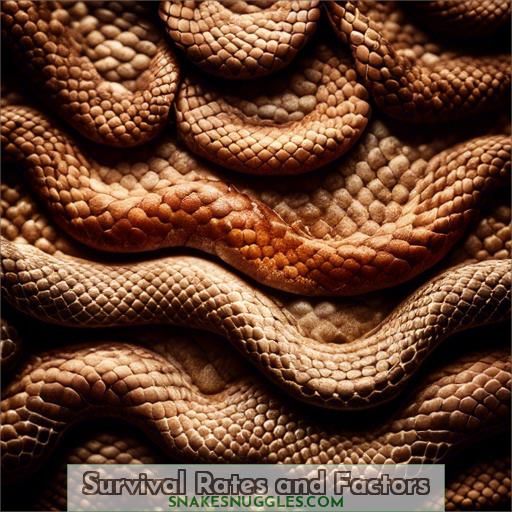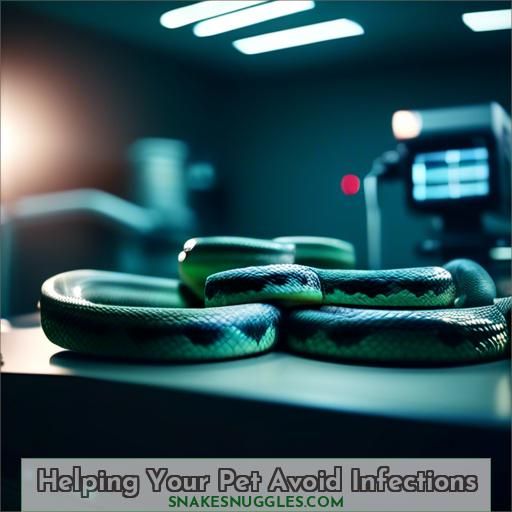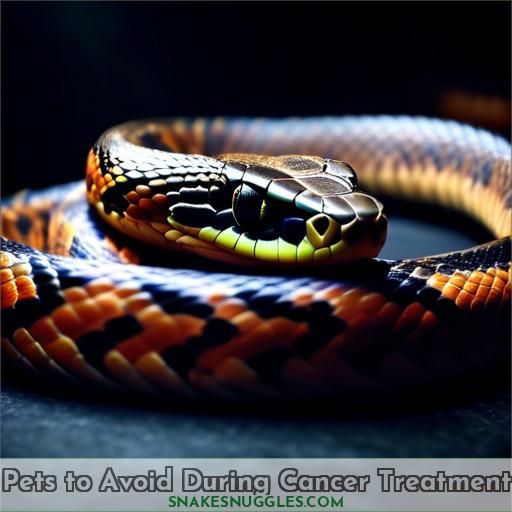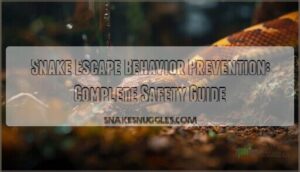This site is supported by our readers. We may earn a commission, at no cost to you, if you purchase through links.
Snakes can develop cancer, with malignant tumors being the primary concern.
Observe for soft tissue sarcomas, the most prevalent malignant tumor type impacting species like Watersnakes and Rattlesnakes.
Indications and symptoms include apparent tumors or growths in diverse locations.
Snakes with malignant neoplasia, metastases, or undefined metastases exhibit elevated mortality rates from their tumors.
While treatment outcomes do not markedly diverge between treated and untreated cases, early detection is imperative.
Acknowledging cancer signs and symptoms is essential, as metastatic effects and tumor placement markedly influence prognosis.
Table Of Contents
- Key Takeaways
- Can Snakes Get Cancer Signs and Symptoms?
- Can Snakes Get Cancer?
- Signs of Cancer in Snakes
- Survival Rates and Factors
- Treatment Options for Snakes
- Common Diseases in Snakes
- Cancer Transmission and Pets
- Reducing Infection Risk From Pets
- Helping Your Pet Avoid Infections
- Pets to Avoid During Cancer Treatment
- Conclusion
Key Takeaways
- Snakes can develop malignant tumors, with soft tissue sarcomas being the most common type.
- Common or Northern Watersnakes, Eastern Diamondback Rattlesnakes, and Timber Rattlesnakes have the highest prevalence of tumors.
- Early detection is crucial for improving survival rates.
- Treatment outcomes do not significantly differ between treated and untreated cases, but early detection and treatment can help snakes survive longer.
Can Snakes Get Cancer Signs and Symptoms?
Yes, snakes can get cancer.
Signs and symptoms of cancer in snakes can include lumps or bumps on the skin, abnormal feeling or discolored skin, and abnormal shedding.
Cancer can take many forms, including lumps within or under the skin, blisters, sores, and abnormal feeling or discolored skin.
Testing will likely be necessary to distinguish cancer from other skin changes and to give a prognosis.
Some cancerous growths may be surgically or otherwise treated, while others, because of size, location, or tumor type, cannot be treated.
Can Snakes Get Cancer?
Yes, snakes can get cancer. The study found that most tumors in snakes are malignant, and the species with the highest tumor prevalence were Common or Northern Watersnakes, Eastern Diamond-Backed Rattlesnakes, and Timber Rattlesnakes. Soft tissue sarcomas were the most common type of malignant tumor found in these snakes.
Signs of Cancer in Snakes
As suggested by the study, snakes can develop malignant tumors, with soft tissue sarcomas being predominant, accounting for 30.2% of cases. Regarding prevalence, certain species like Common or Northern Watersnakes, Eastern Diamond-Backed Rattlesnakes, and Timber Rattlesnakes exhibited a higher incidence of tumors, ranging from 0% to 30.8%.
Tumor Prevalence
Snakes, like all living creatures, can develop tumors. While the exact prevalence of cancer in snakes isn’t well-known, a recent study found that most tumors in snakes are malignant. Soft tissue sarcomas are the most common type of tumor, accounting for 30.2% of all cases. The prevalence of cancer in snakes can vary depending on the species, with some species having a higher incidence than others.
- Species-specific prevalence: Common or Northern Watersnakes (Nerodia sipedon), Eastern Diamond-Backed Rattlesnakes (Crotalus adamanteus), and Timber Rattlesnakes (Crotalus horridus) had the highest prevalence of tumors.
- Tumor location: Malignant tumors can occur in various locations, including the skin, internal organs, and bones.
- Metastatic spread: Snakes with malignant neoplasia, metastases, or indeterminate metastases are more likely to die from their tumors.
Understanding the prevalence of cancer in snakes is essential for veterinary care and conservation efforts. If early diagnosis and treatment are possible, it may help snakes survive longer.
Malignant Tumors
Malignant tumors are the most common form of cancer in snakes, with a prevalence of 86.6%.
The highest prevalence is found in Common or Northern Watersnakes, Eastern Diamond-Backed Rattlesnakes, and Timber Rattlesnakes.
Soft tissue sarcomas are the most common type of malignant tumor, accounting for 30.2% of cases.
The long-term prognosis for snakes with malignant neoplasia, metastases, or indeterminate metastases is poor, as they are more likely to die of cancer.
Treatment recommendations include surgical excision and chemotherapy, but the outcome is not notably different between treated and untreated snakes.
Other diseases, such as infectious stomatitis, septicemia, parasitic infections, and inclusion body disease, can also affect snakes.
Soft Tissue Sarcomas
Soft tissue sarcomas are a type of cancer that can affect snakes, with the highest incidence found in Common or Northern Watersnakes, Eastern Diamond-Backed Rattlesnakes, and Timber Rattlesnakes. These tumors are principally malignant, with soft tissue sarcomas being the most prevalent type, accounting for 30.2% of all neoplasms in snakes. The occurrence of soft tissue sarcomas varies among species, with some species having a higher risk than others.
The signs of soft tissue sarcomas in snakes can include tumors in various locations, such as the skin or internal organs. The tumor location and metastasis prevalence can vary depending on the species and age of the snake. In some cases, soft tissue sarcomas may be associated with genetic predispositions, such as those seen in certain cancer predisposition syndromes.
The age of the snake can also play a role in the incidence of soft tissue sarcomas, with some species having a higher risk in younger animals. Geographic distribution may also influence the prevalence of these tumors, as certain regions may have higher rates of exposure to environmental factors that contribute to the development of soft tissue sarcomas.
Prevention strategies for soft tissue sarcomas in snakes may include monitoring for early signs of tumors, such as changes in behavior or physical appearance, and seeking veterinary care promptly if any abnormalities are detected. Infectious stomatitis, a common disease in snakes, should be addressed to prevent secondary infections that could increase the risk of soft tissue sarcomas. Regular veterinary check-ups can help identify any potential issues early on, allowing for timely intervention and treatment.
Survival Rates and Factors
Snakes with malignant neoplasia (cancer), metastases (spread of cancer to other parts of the body), or indeterminate metastases were more likely to die from their tumors. Notably, treatment outcomes didn’t markedly differ between snakes that received treatment and those that did not, indicating a necessity for further research into effective treatment approaches for snake cancer.
Impact of Malignant Neoplasia
Malignant neoplasia, or cancer, can markedly affect survival rates in snakes.
The incidence of malignant tumors is high, with species such as Common or Northern Watersnakes, Eastern Diamond-Backed Rattlesnakes, and Timber Rattlesnakes being most affected.
The most prevalent tumor type is soft tissue sarcoma, which accounts for 30.2% of malignant tumors.
The incidence of malignant neoplasia varies by species, with some species having no reported cases and others having an incidence of up to 30.8%.
Age and gender do not markedly affect survival rates, but tumor location can play a role.
The presence of metastasis is associated with a higher probability of death from the tumor.
Treatment, such as surgical excision or chemotherapy, may not markedly affect survival times, but these treatments can be associated with death from a cause other than the tumor.
Treatment Efficacy
You might be wondering about the effectiveness of treatment modalities for snakes with cancer. Well, let’s delve into the details.
- Chemotherapy Efficacy: The study found that chemotherapy was associated with death from a cause other than the tumor, but there was no significant difference in survival times for those treated and not treated.
- Non-Surgical Treatments: Other than surgical excision, there are no specific details provided about alternative therapies or palliative care for snakes with cancer.
- Alternative Therapies: The study didn’t mention any alternative therapies or palliative care options for snakes with cancer.
Treatment Options for Snakes
Surgical excision is commonly employed to treat cancerous growths in snakes, involving the complete removal of the tumor and surrounding tissue. Chemotherapy represents another treatment modality, though its use in reptiles remains relatively limited due to challenges associated with dosing and potential side effects.
Surgical Excision
Regarding snake cancer treatment, surgical excision is a prevalent technique. This involves removing the tumor through surgery, which can be performed with anesthesia to maintain the snake’s tranquility during the procedure. The incision is closed with PDS suture material, and the snake’s weight is recorded. It’s then left on the surgical table to recover before being returned to its enclosure.
However, surgical complications and anesthetic risks should be taken into account. Due to the snake’s distinctive anatomy and physiology, veterinarians must be mindful of its tubular body, absence of a diaphragm, and ectothermic nature, which necessitates keeping it warm. Post-operative care is paramount, and recovery times vary, with some snakes shedding the sutures after several months.
The expense of snake surgery is also a consideration, ranging from $150 to $500 per consultation. It’s imperative to discuss potential risks and costs with your veterinarian before selecting a treatment plan.
Chemotherapy
Snakes can be treated with chemotherapy, a common cancer treatment that uses drugs to destroy cancer cells.
Chemotherapy for snakes is not well-studied.
However, some research suggests that snake venom, which contains cytotoxic compounds, may have potential as a cancer therapy.
For example, Celtic Biotech has advanced a snake venom-based cancer therapy into phase 1 human trials, with promising results.
However, the efficacy and side effects of chemotherapy for snakes are not well-documented.
More research is needed to determine the safety and effectiveness of chemotherapy for snakes.
Common Diseases in Snakes
Beyond cancer, snakes can contract various infectious diseases such as stomatitis, septicemia, and respiratory infections caused by bacteria, viruses, fungi, or parasites. They’re also susceptible to internal parasites like helminths, protozoa, and coccidia, as well as external parasites like ticks and mites, which may carry disease-causing pathogens.
Infectious Diseases
Snakes can indeed suffer from infectious diseases, with stomatitis being a major concern.
Stomatitis, also known as mouth rot, is characterized by symptoms such as pinpoint or patch hemorrhage on the gums, thick mucus in the mouth, red, inflamed skin, fluid-filled blisters, diarrhea, and anemia.
In severe cases, it can lead to systemic disease and possible death.
The primary cause of stomatitis in snakes is damage to the mouth, often due to stress, poor husbandry, or inadequate vivarium design.
Treatment typically involves antimicrobial therapy for the primary lesions, correcting underlying husbandry problems, and increasing the environmental temperature to boost the snake’s immune system.
Parasitic Diseases
Snakes can suffer from various parasitic diseases, such as those caused by helminths, protozoa, and coccidia. These infections can lead to symptoms like diarrhea, weight loss, and anemia. To prevent these issues, make sure your snake’s environment is clean, and provide regular veterinary check-ups.
Skin Infections
When your snake’s skin turns as red as a stop sign and starts sporting fluid-filled blisters, it’s waving a big, scaly flag for bacterial infections. Don’t just hiss in dismay; these signs demand immediate attention. It’s not just a skin-deep issue; it’s a health hazard lurking beneath.
Respiratory Diseases
Respiratory diseases are a common clinical presentation in snakes, and they can be caused by various bacterial, fungal, viral, and parasitic infections, as well as noninfectious diseases. Some common respiratory diseases in snakes include:
- Bacterial pneumonia: Most cases of pneumonia in snakes are caused by bacterial infections of the lung, which may be aerobic (living in air) or anaerobic. Common bacterial pathogens include Pseudomonas sp., Klebsiella sp., Aeromonas sp., E. coli., and Proteus.
- Fungal bronchitis: While primary fungal pneumonias are rare, secondary fungal infections aren’t uncommon. Fungal pathogens can cause inflammation and damage to the respiratory system.
- Parasitic lungworms: Lung mites (Entonyssus spp), lungworms (Rhabdias spp), and pentastomids can live in or migrate through the lungs of snakes, potentially predisposing them to pneumonia.
- Viral tracheitis: An ophidian paramyxovirus (Fer-de-Lance Virus) can damage lung tissue, leading to secondary bacterial pneumonia.
To diagnose respiratory diseases in snakes, veterinarians may use a combination of techniques, including physical examination, auscultation, radiography, and endoscopic evaluation. Treatment for respiratory diseases in snakes depends on the underlying cause and may involve antibiotics for bacterial infections, supportive care for viral infections, or anthelmintics for parasitic infections.
Cancer Transmission and Pets
Cancer is not contagious and cannot be spread to pets or anyone else.
However, cancer treatment can pose risks to pets, particularly if they are exposed to body fluids.
External beam radiation does not make you or your body fluids radioactive.
To reduce the risk of infection from pets, avoid scratches and bites, keep pets’ nails trimmed, and clean pet food and water bowls often.
Inform your veterinarian about cancer treatment and potential risks, and keep pets up-to-date on vaccinations.
Reducing Infection Risk From Pets
You must exercise caution when handling snakes, especially during cancer treatment, as scratches and bites can transmit harmful bacteria or viruses. Additionally, contact with snake feces, urine, saliva, or vomit should be avoided, as these substances may contain infectious agents that could compromise your weakened immune system.
Scratches and Bites
Concerning pet safety, preventing scratches and bites is essential.
Snakes, similar to any other pet, can inflict injuries. To reduce the likelihood of infection, ensure proper wound care and infection management.
Maintain your snake’s nails trimmed and avoid scratches. In the event of bites, seek veterinary attention immediately.
Feces and Urine
Feces and urine are two essential components of a reptile’s waste. While they’re typically not associated with cancer, they can carry pathogens that may pose health risks to humans. Here are four ways to reduce infection risk from feces and urine:
- Proper Hygiene: Always wash your hands after handling your pet or cleaning their enclosure. This is especially important if you’re handling their feces or urine.
- Avoid Direct Contact: If possible, avoid direct contact with your pet’s feces or urine. If you must handle these substances, use gloves and wash your hands thoroughly afterwards.
- Clean Up Promptly: Regularly clean your pet’s enclosure to prevent the buildup of bacteria in their waste. This will help reduce the risk of infection for both your pet and yourself.
- Maintain a Clean Environment: Keep your pet’s living space clean and free of debris. This will help reduce the risk of infection from bacteria that may be present in their waste.
Licking, Saliva, and Vomit
When dealing with snakes, it’s essential to be aware of the potential hazards related to their saliva, vomit, and licking.
Snake saliva can harbor bacteria that can cause infections in humans, especially if the snake has a compromised immune system.
Similarly, snake vomit can contain bacteria and parasites that may pose a risk to human well-being.
To reduce the risk of infection, refrain from kissing, cuddling, or sleeping with your snake.
Additionally, wash your hands after handling your snake, and avoid touching your face or eyes after interacting with them.
Touch (Petting and Holding)
Regarding the reduction of infection risk from your snake, touch is another crucial aspect to bear in mind.
The frequency, duration, location, pressure, and temperature of your touch can all have an impact on the potential for infection transmission.
To minimize risk, abstain from touching your snake’s mouth, eyes, or wounds.
If handling your snake is necessary, wash your hands both before and after.
Endeavor to keep touch sessions brief and gentle.
Helping Your Pet Avoid Infections
As a sensible pet owner, you aim to guarantee your snake’s health and welfare.
Routine pet grooming is paramount.
Maintain your snake’s dwelling clean, and verify they have access to fresh water at all times.
Vaccinate your snake as per your veterinarian’s advice.
Refrain from feeding them expired or contaminated food.
Clean their food and water bowls frequently to inhibit bacterial proliferation.
If you possess indoor cats, isolate them from your snake’s habitat to prevent the transmission of potential infections.
By adhering to these simple measures, you can help your pet avoid infections and maintain a healthy lifestyle.
Pets to Avoid During Cancer Treatment
//www.aicr.org/resources/blog/caring-for-pets-while-you-have-cancer-what-you-need-to-know/
Caring For Pets
Conclusion
Coincidentally, recognizing can snakes get cancer signs and symptoms early is pivotal for effective intervention. Stay vigilant for abnormalities like tumors or growths. Implement stringent hygiene practices when handling reptilian companions to mitigate transmission risks. Promptly consult a veterinary professional if concerning symptoms manifest, as swift action optimizes prognosis and safeguards your cherished pet’s well-being.
















